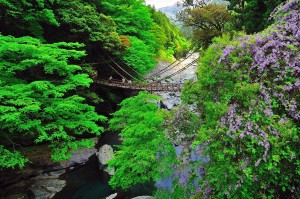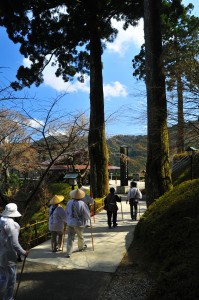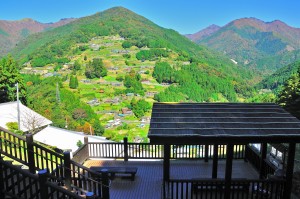Tokushima Prefecture is located in the eastern part of Shikoku, and is connected to Japan’s main island of Honshu via a bridge across Awaji Island. It is about 2.5 hours by car from Osaka. The population is about 750,000 people, the fourth smallest prefecture in the country, and is a peaceful place blessed with nature such as mountains and rivers. The climate is relatively mild, and the cultivation of citrus fruits such as sudachi (a small, round, green citrus fruit of Japanese origin widely used in Japanese cuisine), oranges, and yuzu (also a citrus fruit) flourishes.
The Iya area in the west is said to be one of Japan’s three greatest ‘hidden gems’, with a beautiful valley. There are bridges made with kazura (vine), and settlements where private houses have spread on the slopes of the mountains, and in recent years it has become very popular with foreign tourists.
The most vibrant event in the year in Tokushima is the Awaodori, or Awa Dance Festival in August. Awaodori is a traditional Japanese dance and has a history of about 400 years. Wearing distinctive kimono, women dance gracefully to the music while the men dance dynamically.
The Shikoku Pilgrimage Trail has 88 temple sites on the island with 23 temples in Tokushima Prefecture. Pilgrims can be seen wearing the traditional white making their pilgrimages here and there throughout the prefecture on a trail representing the path to enlightenment.
Tourist information about Tokushima Prefecture (link)
Although Tokushima Prefecture has many natural and traditional cultural attractions like this, depopulation is progressing particularly in mountainous areas, and the proportion of people over 65 years old in some towns exceeds 50%. To tackle this Tokushima Prefecture is implementing initiatives to attract satellite offices as part of measures for depopulation and regional revitalization. Satellite office policies support remote office working for companies and government agencies headquartered in cities such as Tokyo.
In Tokushima Prefecture, the high-speed optical fibre network is stretched out throughout the mountain area, and any desk based work in business is possible remotely with little inconvenience.
Tokushima Prefecture collaborates with related municipalities and an NPO in holding seminars in Tokyo, as well as field visit tours and consulting, to support people who wish to open satellite offices. As of March 2018, 56 companies, mainly IT and design related companies, have satellite offices in Tokushima Prefecture, mainly in the mountains and coastal areas.
The primary advantage of satellite office is not having to commute to work for long periods, so workers can effectively use the time before starting and after finishing office hours, with their families and for better work-life balance. In major cities of Japan, it is often necessary to ride crowded trains for more than an hour, and even the less urban areas of the prefectures, traffic makes for long commute by car. In that respect, in rural areas workers can live near the office with cheap rent. It makes it more possible to spend meaningful time doing outdoor sports and farming work or other hobbies before starting and after finishing work as well as a heightened sense of community in smaller areas. There is also more time to spend with family.
Now, as part of a new trend in working in Japan, satellite offices are attracting more and more attention. In Tokushima Prefecture, the plan is to continue with the initiatives with even more in the future.




